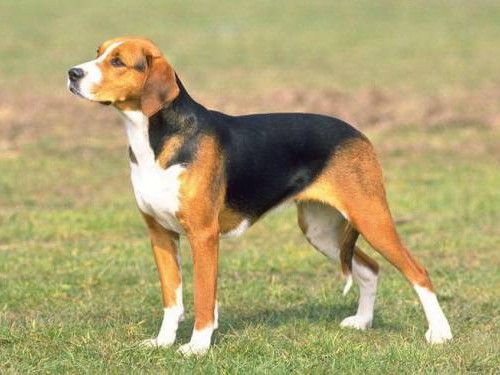The Swiss Hound is reputedly one of the Group of Hounds’ earliest breeds. Swiss working dogs were among the best, according to a letter written in the fifteenth century to Ernst, the Elector of Saxony (1441–1486). Packs of hounds “with the same color and the same size, large heads and very long ears” are seen in images from the 17th century.
The German dog writer Richard Strebel stated three centuries later in “Die Deutschen Hunde” (German dog breeds, 1903-05) that the hounds that evolved independently were the ones who lived apart in a confined region of Switzerland.
Despite the breeding of Schwyz, Bernese, and Lucerne hounds, it appeared in the decade of 1890 that purebred bloodhounds were doomed to die in Switzerland. A few hounds were sent to Scandinavia, where they were crossing with native hounds, the Stövares (scandinavian hounds) they were blooming. But at the same time, the Thurgauer Laufhund quietly disappeared in Switzerland, and the Aargauer Laufhund gave way to Jura Hound (Bruno Jura Hound).
The Schweizerische Laufhunde-Club (Switzerland Hound Club) was established in 1903 by J. Dust del Swiss Kennel Club, and in 1907 a call was made to prevent the extinction of the Swiss hound. Subsequently, an amazing thing occurred: the breed club purchased superior Swiss hounds and gifted them to judicious hunters and breeders. One dog at a time was allowed when hunting; dogs had to be under control when looking for game; dogs that vanished during the hunt had to find their masters within 30 minutes; and dogs were to return as soon as the horn sounded, regardless of whether the dogs were looking. These test rules and regulations were developed. By following these guidelines, the
Breed Information
Another Name Schweizerischer Niederlaufhund
Origin Switzerland
Height Males 36-38 cm
Females 33-36 cm
Weight 10-16 kg
Fur Smooth
Color White with black and reddish-brown undercoat; black with reddish-brown undercoat; blue-black with black spots; white with orange-red spots
Lifespan 10-14 years
FCI Classification Scent hounds and related breeds
Group Hunting dogs
Appearance
The Small Swiss Hound is a small dog—some may even say miniature—but it’s elegant and powerful. The lovely long neck supports the elongated, narrow skull. Powerful limbs and a thin tail that can raise when aroused complete the well-developed thorax. The round eyes and lengthy ears dangle down. The Small Swiss Hound representatives can grow up to 45 cm in height and weigh up to 15 kg at their withers. In addition to sharing a similar body type and look, short-legged Swiss hounds can also be identified by their color:
• Small Bernese Hound: white with black spots or black saddle and underpain.
• Small Jura Hound: Pale with black chapper, sometimes with black smokiness; black and tan; a small white spot on the chest is allowed.
• Small Lucerne Hound: blue (of black and white hair), dense mottling with black spots or black saddle and underpain; black cheprak is allowed.
• Small Schwyz Hound: white with orange spots or orange saddle; orange cheprak allowed.
Character
The Small Swiss Hound is a tough canine breed with a keen sense of scent and ringing bark, much like its larger siblings. It is fairly amiable and has a well-balanced personality. Hounds are quite quick to change; during a hunt, their complete tranquility at home is replaced with frantic activity and relentless chase. The breed is known for its unwavering obedience to its owner and willingness to follow him to the ends of the earth. Members of this type are cautious around strangers and will never openly attack a man. It can function well as a watchdog and responds delicately to any suspicious rustles or noises.
Care
Members of the breed The small Swiss Hound is not fussy, carefree, and does not mind the cold. Small hunters’ modesty has been cared after by breeders. The Small Swiss Hound might become bored and start barking and whimpering loudly when left alone. In this situation, it’s best to either buy a few young puppies of this breed at once or raise them in the owner’s home with his family. She won’t have time to be bored then, for sure. Frequent walks in the fresh air are the primary requirement for maintaining fitness. The furious energy of the tiny hound should be periodically released rather than building up. Short hair is exempt from the process of shedding; it is enough to wipe the pet with a damp towel after walks. Eye washing, brushing teeth, and ears are daily procedures that should not be neglected.
Instruction
Small Swiss Hounds are easy to train, even for an average amateur. The dog is quite intelligent and quick to pick things up. Early socialization is necessary if you want your pet to respond appropriately to other dogs and cats and possibly become friends with them. Playing with him and rewarding him with food when he obeys an order properly are both wise decisions.
Typical Illnesses
The Small Swiss Hound is known for its robust health. A well-groomed example of a Small Swiss Hound that is fed a balanced food and has unrestricted access to the outdoors seldom becomes ill. This breed may be more susceptible to ear canal inflammatory illnesses due to the structural features of its long ears. Chronic otitis media is exacerbated by obstructed air access so careful attention should be paid to the cleanliness of the ear canal of these dogs.
Nutrition
Dogs who are lightweight need to pay more attention to their food. A diet that is well-balanced is more crucial. The diet needs to be closely followed in order to fit all of its required ingredients into a tiny amount of food. The foundation of a Small Swiss Hound dog’s diet consists of small bits of raw, lean meat. Meat broth can be used to make a thick vegetable soup, and milk can be used to make porridges or liquid oatmeal.

